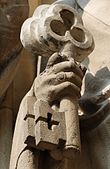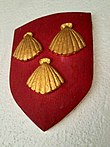Saint symbolism
Symbolism of Christian saints has been used from the very beginnings of the religion.[1] Each saint is said to have led an exemplary life and symbols have been used to tell these stories throughout the history of the Church.[2] A number of Christian saints are traditionally represented by a symbol or iconic motif associated with their life, termed an attribute or emblem, in order to identify them. The study of these forms part of iconography in art history.[3] They were particularly used so that the illiterate could recognize a scene, and to give each of the Saints something of a personality in art.[2] They are often carried in the hand by the Saint.
Attributes often vary with either time or geography, especially between
Four Evangelists
| Saint | Symbol[5] |
|---|---|
| Matthew | winged man or angel |
| Mark | winged lion |
| Luke | winged bull |
| John | eagle |
The Apostles
-
The Synaxis of the Twelve Apostles. Russian, 14th century, Moscow Museum.
-
Thekeyas symbol of St. Peter
-
Stained glass window showing flaying knife, symbol of St. Bartholomew
-
Scallop Shells, St. James the Great
| Saint | Symbol |
|---|---|
| Andrew | St. Andrew's cross[a], discalced, with fish or a rope |
| Bartholomew the Apostle | knife, bears his own skin in hand[a] |
James, son of Zebedee
|
|
James the Just
|
|
| John | evangelistary, a serpent in a chalice, cauldron, eagle[a]
|
| Jude | |
| Judas Iscariot | thirty pieces of silver[a] |
| Matthew | angel, evangelistary[a] |
| Peter | inverted cross, holding a book or scroll, with a bushy beard and hair.[a]
|
| Philip | column; holding a basket of loaves and a Tau Cross[a]
|
| Simon | boat; cross and saw; fish (or two fishes); lance; being sawn in two longitudinally; oar[a] |
| Thomas | placing his finger in the side of Christ, axe, spear, carpentry tools [a] |
Mary, mother of Jesus
-
Mary Immaculate
-
A traditional depiction of Mary by Fra Angelico wearing a blue mantle
-
Our Lady of Candelaria
Mary is often portrayed wearing
| Title | Symbol |
|---|---|
| Black Madonna of Częstochowa | Infant Jesus , fleur-de-lis robes, slashes on right cheek
|
| Immaculate Heart of Mary | Burning bloodied heart, pierced with a sword, banded with roses, and lily flowers |
| Our Lady of Aparecida | In traditional form of Immaculate Conception [citation needed] |
Our Lady of Camarin |
Mary on crescent moon[citation needed] |
Our Lady of Candelaria |
Black Madonna with candle in one hand, and Infant Jesus in the other hand. Jesus carries a small bird in his hands.[citation needed] |
| Our Lady of Charity | Carrying the Christ child and holding a crucifix atop an inverted crescent moon, with triple cherubs, encrusted with jewels and golden crown and aureole halo, embroidered gold mantle with the Cuban flag[citation needed] |
Our Lady the Garden Enclosed |
Statue of Our Lady of Sorrows holding a white handkerchief, gold crown and jewelry, richly embroidered mantle[citation needed] |
| Our Lady of Copacabana | Infant Jesus, straw basket, pigeons, baton, gold Quechua jewelry[citation needed ]
|
| Our Lady of Cotoca | white embroidered mantle, gold crown and jewelry, scapuler[citation needed] |
| Our Lady of Fátima | dressed in white, giving out rays of clear and intense light[7] |
| Our Lady of Good Counsel | with the Infant Jesus, in their touching halo appear the words SS. Mater Boni consilii, ora pro nobis Jesum filium tuum |
| Our Lady of Guadalupe | pregnant, eyes downcast, hands clasped in prayer, clothed in a pink tunic robe covered by a cerulean mantle with a black sash, emblazoned with eight-point stars; eclipsing a blazing sun while standing atop a darkened crescent moon, a cherubic angel carrying her train |
Our Lady of Humility |
Mary seated low to the ground, usually holding the baby Jesus[citation needed] |
| Our Lady of Itatí | in prayer, with blue embroidered mantle, solar crown, veil[citation needed] |
| Our Lady of Lebanon | Blessed Virgin Mary with outstretched hands, bronze crown[citation needed ]
|
| Our Lady of Lourdes | dressed in a flowing white robe, with a blue sash around her waist[8] |
| Our Lady of Luján | in prayer, with a golden crown, embroidered blue mantle over white robe, sliver of moon[citation needed] |
| Our Lady of Navigators | held by angels, with mantle, jewelry, crown, halo of stars; the Infant Jesus is holding an anchor [citation needed ]
|
| Our Lady of Peace | Infant Jesus, olive branch, dove[citation needed ]
|
| Our Lady of Peace and Good Voyage | dark complexion, enlarged iris, unbound hair[citation needed] |
| Our Lady of Peñafrancia | Holy Child, Mantum[citation needed ]
|
| Our Lady of Piat | dark complexion, the Child Jesus, rosary, crown, flowers[citation needed ]
|
| Our Lady of San Juan de los Lagos | in prayer, with golden crown, white gown, blue mantle, silver banner held by angels[citation needed] |
| Our Lady of Sorrows | in mournful state, tears, bleeding heart pierced by seven swords [b] |
| Our Lady of the Most Holy Rosary, Queen of the Caracol | with the baton[citation needed ]
|
| Our Lady of the Rosary of Chiquinquirá | standing on a crescent moon, blue cloak, white veil, holding the Infant Jesus. With bird, rosary, scepter, accompanied by Saints Anthony of Padua and Andrew[citation needed] |
| Our Lady of the Rosary | with the Infant Jesus, crown, rosary[citation needed ]
|
| Our Lady of the Visitation of Guibang | ivory statue[citation needed] |
| Our Lady of Vendôme | with the Infant Jesus[citation needed ]
|
| Our Mother of Sheshan | standing on top a Infant Jesus in cruciform gesture[citation needed ]
|
| Rosa Mystica | with a rose[citation needed] |
| Queen of Heaven | with a crown of stars, flowers[a] |
| Virgen de los Remedios de Pampanga | The Blessed Virgin Mary encrusted with jewels, golden crown, aureole and moon.[citation needed] |
| Virgen del Valle | Mary in a white dress[citation needed] |
| Virgin of Mercy | sheltering people under her mantle[citation needed] |
| Virgin of Miracles | Gothic carving of Mary with a baby in alabaster[citation needed] |
| Virgin of Montserrat | Statue painted in Throne of Wisdom holding an orb of the earth in her right hand[9]
|
| Virgin of the Thirty-Three | assumpted into heaven, white robe, blue cloak, golden bejeweled crown, sliver of moon held by cherubs[citation needed] |
| Our Lady of Mount Carmel | dressed in the colors of the Carmelite habit, wearing the mantle of the brown scapular, sometimes handing it to Saint Simon Stock
|
Saints listed by name
Saints (A–H)
Saints (I–P)
Saints (Q–Z)
See also
Notes
- "List of saints". Catholic Online. Your Catholic Voice Foundation.
- Stracke, Richard (October 20, 2015). "Iconography". Christian Iconography.
- Rabenstein, Katherine (April 1999). "Saint of the Day Master Index". St. Patrick Catholic Church. Archived from the original on April 20, 2018.
References
- ^
 This article incorporates text from a publication now in the public domain: Herbermann, Charles, ed. (1913). "Symbolism". Catholic Encyclopedia. New York: Robert Appleton Company.
This article incorporates text from a publication now in the public domain: Herbermann, Charles, ed. (1913). "Symbolism". Catholic Encyclopedia. New York: Robert Appleton Company.
- ^ a b Mayernik, David T. (2018). "A Vast, Immeasurable Sanctuary: Iconography for Churches". Sacred Architecture Journal. 5: 22.
- ^ "Eastern Orthodox and Catholic teaching about Icons".
- ^ Hassett, M. (1911). "Palm in Christian Symbolism". The Catholic Encyclopedia.
- ISBN 978-0-8132-0117-7.
- ^ Kugeares, Sophia Manoulian (1991). Images Of The Annunciation Of The Virgin Mary Of The 13th, 14th And 15th Century.
- ^ Arcement, Katherine (October 13, 2017). "Our Lady of Fatima: The Virgin Mary promised three kids a miracle that 70,000 gathered to see". Washington Post.
- ISBN 0-71-399186-0.
- ^ Roccosalvo C.S.J., Joan L. (Spring 2012). "Elegance Personified: The Black Madonna of Montserrat". Sacred Architecture Journal.
Further reading
- Delaney, John P. (1980). Dictionary of Saints (Second ed.). Garden City, NY: Doubleday. ISBN 0-385-13594-7.
- Greene, E. A. (1909). Saints and their symbols : a companion in the churches and picture galleries of Europe. London : Whittaker & Co.Greene, E. A. (1909). Saints and their symbols : a companion in the churches and picture galleries of Europe. London : Whittaker & Co.
- Lanzi, Fernando; Lanzi, Gioia (September 1, 2004). Saints and their Symbols: Recognizing Saints in Art and in Popular Images. Translated by O'Connell, Matthew J. ISBN 9780814629703.
- Post, W. Ellwood (1975). Saints, Signs and Symbols (2 ed.). SPCK Publishing. ISBN 9780281028948.
- ISBN 978-0821203651.
- Walsh, Michael (2007). A New Dictionary of Saints: East and West. Liturgical Press. ISBN 978-0-8146-3186-7.
- Whittemore, Carroll E. (1980). Symbols of the Church. Abingdon Press. ISBN 0687183014.
- Rabenstein, Katherine (April 1999). "Bibliography on Saints and Sainthood". St. Patrick Catholic Church. Archived from the original on April 10, 2018.








